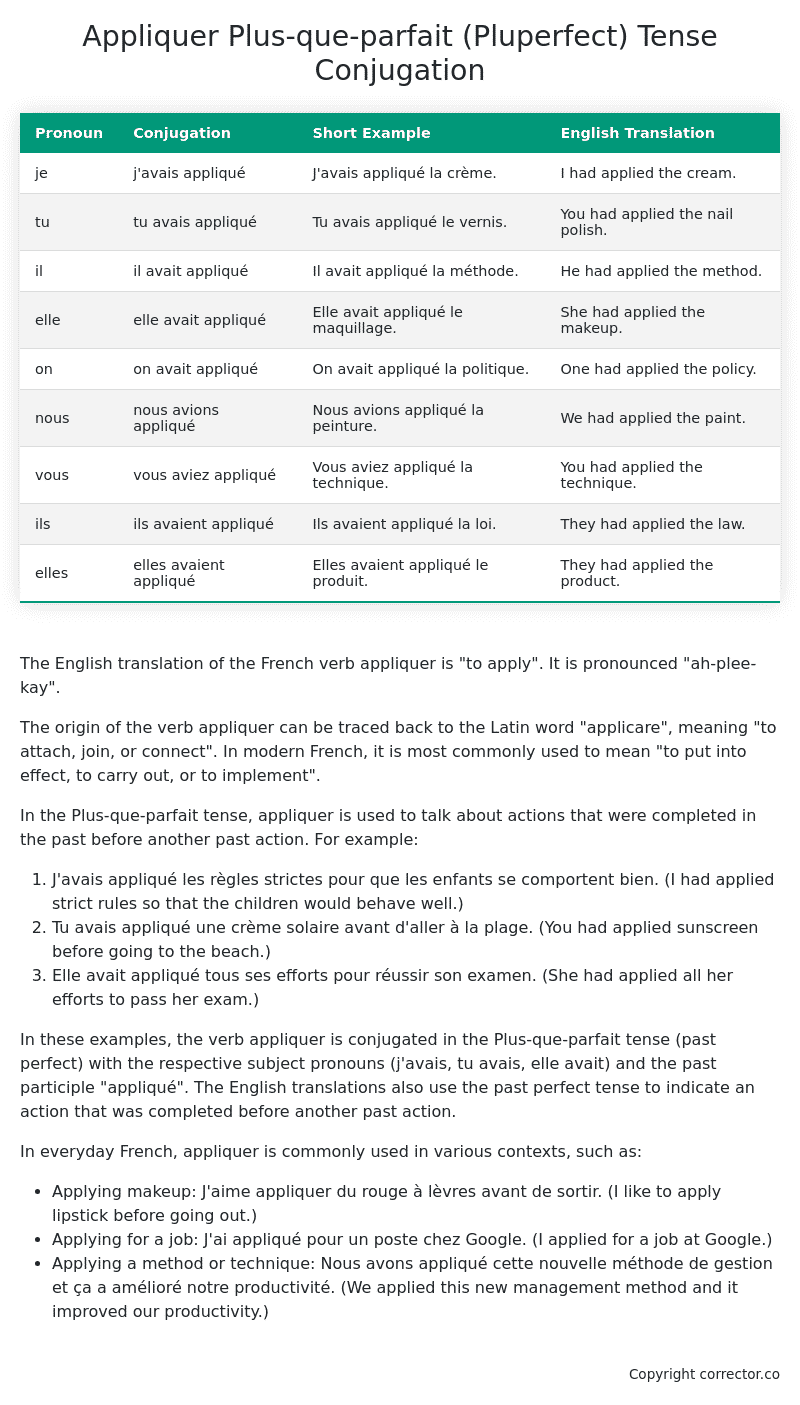Plus-que-parfait (Pluperfect) Tense Conjugation of the French Verb appliquer
Introduction to the verb appliquer
The English translation of the French verb appliquer is “to apply”. It is pronounced “ah-plee-kay”.
The origin of the verb appliquer can be traced back to the Latin word “applicare”, meaning “to attach, join, or connect”. In modern French, it is most commonly used to mean “to put into effect, to carry out, or to implement”.
In the Plus-que-parfait tense, appliquer is used to talk about actions that were completed in the past before another past action. For example:
- J’avais appliqué les règles strictes pour que les enfants se comportent bien. (I had applied strict rules so that the children would behave well.)
- Tu avais appliqué une crème solaire avant d’aller à la plage. (You had applied sunscreen before going to the beach.)
- Elle avait appliqué tous ses efforts pour réussir son examen. (She had applied all her efforts to pass her exam.)
In these examples, the verb appliquer is conjugated in the Plus-que-parfait tense (past perfect) with the respective subject pronouns (j’avais, tu avais, elle avait) and the past participle “appliqué”. The English translations also use the past perfect tense to indicate an action that was completed before another past action.
In everyday French, appliquer is commonly used in various contexts, such as:
- Applying makeup: J’aime appliquer du rouge à lèvres avant de sortir. (I like to apply lipstick before going out.)
- Applying for a job: J’ai appliqué pour un poste chez Google. (I applied for a job at Google.)
- Applying a method or technique: Nous avons appliqué cette nouvelle méthode de gestion et ça a amélioré notre productivité. (We applied this new management method and it improved our productivity.)
Table of the Plus-que-parfait (Pluperfect) Tense Conjugation of appliquer
| Pronoun | Conjugation | Short Example | English Translation |
|---|---|---|---|
| je | j’avais appliqué | J’avais appliqué la crème. | I had applied the cream. |
| tu | tu avais appliqué | Tu avais appliqué le vernis. | You had applied the nail polish. |
| il | il avait appliqué | Il avait appliqué la méthode. | He had applied the method. |
| elle | elle avait appliqué | Elle avait appliqué le maquillage. | She had applied the makeup. |
| on | on avait appliqué | On avait appliqué la politique. | One had applied the policy. |
| nous | nous avions appliqué | Nous avions appliqué la peinture. | We had applied the paint. |
| vous | vous aviez appliqué | Vous aviez appliqué la technique. | You had applied the technique. |
| ils | ils avaient appliqué | Ils avaient appliqué la loi. | They had applied the law. |
| elles | elles avaient appliqué | Elles avaient appliqué le produit. | They had applied the product. |
Other Conjugations for Appliquer.
Le Present (Present Tense) Conjugation of the French Verb appliquer
Imparfait (Imperfect) Tense Conjugation of the French Verb appliquer
Passé Simple (Simple Past) Tense Conjugation of the French Verb appliquer
Passé Composé (Present Perfect) Tense Conjugation of the French Verb appliquer
Futur Simple (Simple Future) Tense Conjugation of the French Verb appliquer
Futur Proche (Near Future) Tense Conjugation of the French Verb appliquer
Plus-que-parfait (Pluperfect) Tense Conjugation of the French Verb appliquer (this article)
Passé Antérieur (Past Anterior) Tense Conjugation of the French Verb appliquer
Futur Antérieur (Future Anterior) Tense Conjugation of the French Verb appliquer
Subjonctif Présent (Subjunctive Present) Tense Conjugation of the French Verb appliquer
Subjonctif Passé (Subjunctive Past) Tense Conjugation of the French Verb appliquer
Subjonctif Imparfait (Subjunctive Imperfect) Tense Conjugation of the French Verb appliquer
Subjonctif Plus-que-parfait (Subjunctive Pluperfect) Tense Conjugation of the French Verb appliquer
Conditionnel Présent (Conditional Present) Tense Conjugation of the French Verb appliquer
Conditionnel Passé (Conditional Past) Tense Conjugation of the French Verb appliquer
L’impératif Présent (Imperative Present) Tense Conjugation of the French Verb appliquer
L’infinitif Présent (Infinitive Present) Tense Conjugation of the French Verb appliquer
Struggling with French verbs or the language in general? Why not use our free French Grammar Checker – no registration required!
Get a FREE Download Study Sheet of this Conjugation 🔥
Simply right click the image below, click “save image” and get your free reference for the appliquer Plus-que-parfait tense conjugation!

Appliquer – About the French Plus-que-parfait (Pluperfect) Tense
Tense Formation
Common everyday usage patterns
Sequencing of past events
Background information
Hypothetical or reported speech
Interactions with other tenses
Summary
I hope you enjoyed this article on the verb appliquer. Still in a learning mood? Check out another TOTALLY random French verb conjugation!


